Centipedes make their way indoors for food and shelter. They prefer dark humid environments such as basements.
Like other pests, centipedes can signal a more serious pest problem. Eliminating them often involves first dealing with the centipedes and then commanding preventive measures that keep them away from the house for good.
Table of Contents
What Are Centipedes?
Centipedes are elongated predatory arthropods. They are known for having many pairs of legs. Centipedes have as many as 382 legs.
There are thousands of centipedes around the world. Most have a body size of up to a few inches.
These arthropods are known for living in the soil, under piles of leaves, under logs, under stones, and in basements.
Centipedes rapidly dehydrate whenever they are taken out of these environments.
Why do Centipedes Live in The Basement?
Centipedes live all outdoors all over the world. They are known to be adapted to living in the ground or above the ground under the cover of rocks, logs, and leaves for high humidity.
There are 3 main reasons why centipedes live in basements.
- Food
- Water
- Shelter
Homes tend to attract centipedes through a combination of these elements rather than through one of them alone.
They would not seek out food inside homes without humidity.
Furthermore, centipedes are attracted to insects and bugs that make their way indoors.
They are known for eating cockroaches, spiders, bed bugs, silverfish, and other pests commonly attracted to food inside the house.
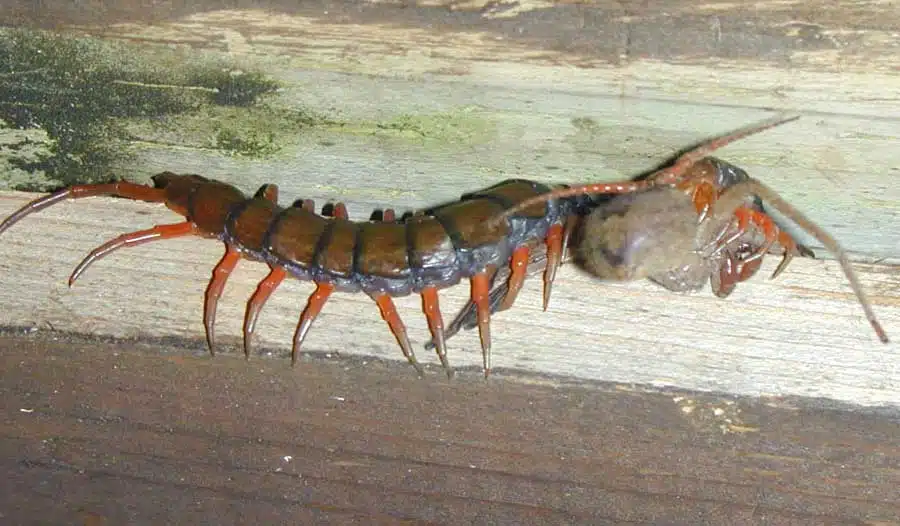
Many of these pests are also found in humid areas of the house such as basements. Since most of these pests are nocturnal, the nocturnal centipede also prefers the dark environments basements provide.
What types of centipedes usually live in the basement?
The House centipede is the most common type of centipede found in basements across North America. It mainly looks for insects and bugs to feed on.
House centipedes
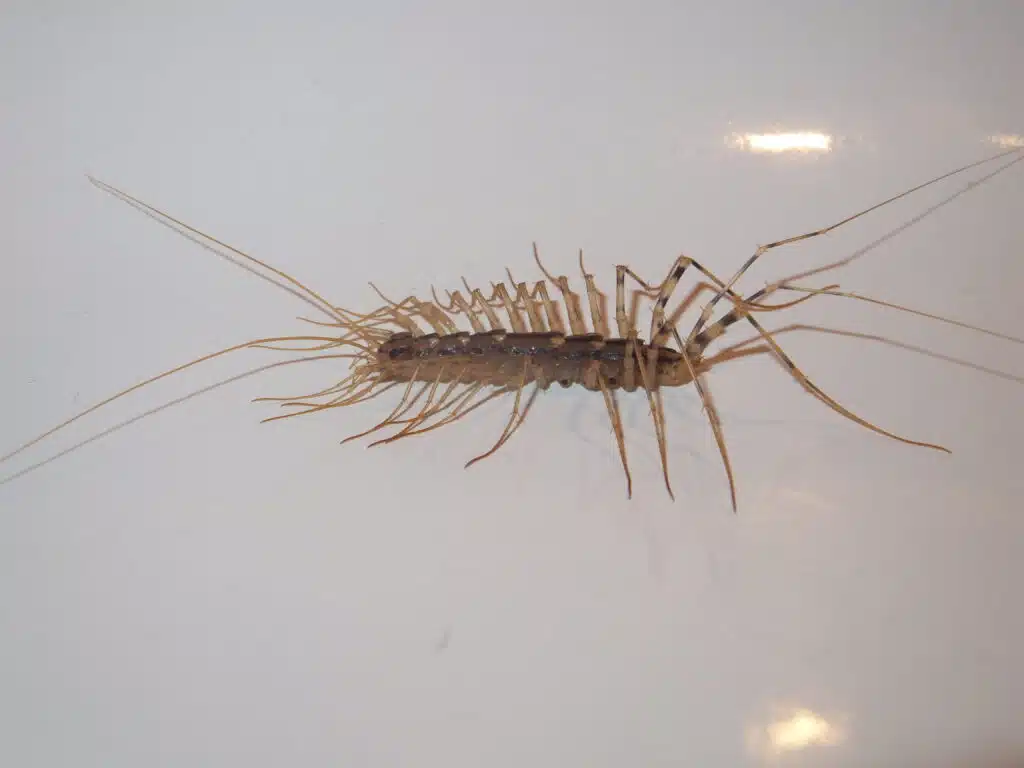
House centipedes (Scutigera coleoptrata) are known as the most common types of centipedes in North American homes. They grow to a size between 25 and 35mm and are known for having 15 pairs of legs.
As their name suggests, these centipedes can also live outdoors. On the other hand, they can also live indoors.
House centipedes can live their entire lives indoors.
They prefer the ground floor and basements for the high humidity and readily available insects such as ants, spiders, silverfish, and bed bugs.
These centipedes can bite people, but they prefer to flee when discovered.
Some House centipedes are routinely found in the bathroom where there’s even higher humidity.
Bark centipedes
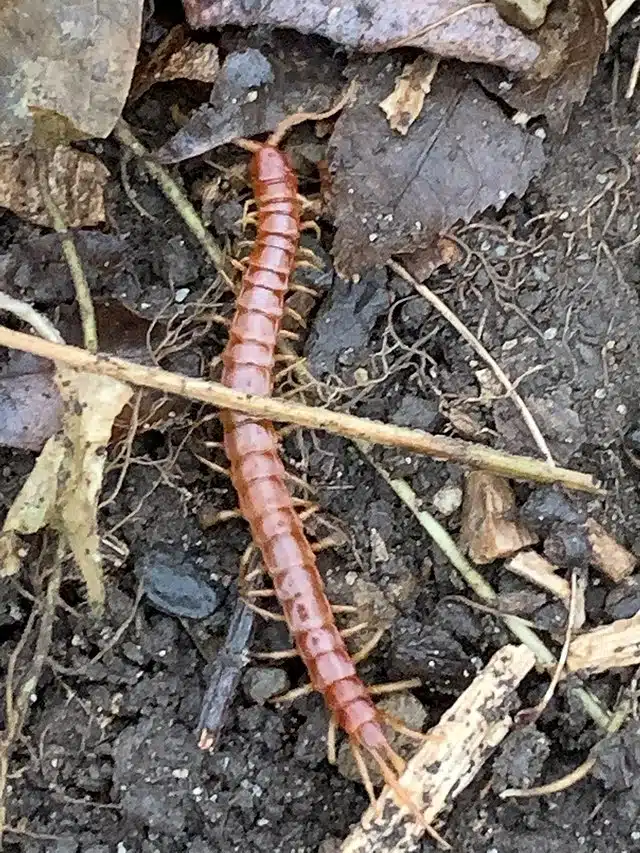
Bark centipedes (Scolopocryptops sexspinosus) prefer to live outdoors. They are sometimes found inside, particularly in basements and garages where dim lighting and higher humidity favor their preferences.
Like all centipedes, Bark centipedes can bite. They have been shown to bite people. Bark centipedes use their venom to subdue prey such as spiders.
Are Centipedes in The Basement Dangerous?
Centipedes aren’t generally dangerous. Even if they bite, they cannot pierce through human skin.
Some data suggests these arthropods can bite through the thinner skin of babies, but bites are very rare.
In general, centipedes are considered harmless to people. They are also considered harmless to plants inside the house as they do not eat flowers and plants as millipedes do.
- Centipedes can’t bite
Centipedes can’t bite people. This is due to the fact they prefer to run away. Most centipedes hide under clothes, boxes, and other types of objects laying on the floor in the basement.
Whenever you pick these objects up to reveal centipedes they run away. It’s rare for centipedes to bite you even while you sleep.
Some biting cases are heard of. But they are cases with serious centipede infestations which are normally seen in a home with serious cockroach infestations which are not inhabitable in the first place.
- The venom of centipedes isn’t dangerous
All centipedes are venomous. They rely on venom to subdue prey and control it. Venom in centipedes is considered harmless to humans.
- Some mild reactions can appear in the case of a bite
Signs of a centipede bite are easy to identify in rare cases this happens. Local swelling is specific in the area of the bite. Skin can turn red for up to 48 hours in the area of the bite. Pain associated with the bite tends to fade away quickly.
Are centipedes beneficial?
Centipedes can also be beneficial. Some people never kill centipedes inside the house as they control other pests.
These people only recommend diminishing humidity levels as the sole method of controlling centipedes.
Centipedes are known to eat a wide range of house pests. This makes them rather beneficial even if they can carry bacteria.
Most centipedes will not live in homes without spiders, roaches, or flies. These centipedes are bound to go out and seek ants or other insects instead of starving indoors.
They might only return indoors to seek shelter in case of low temperatures.
Signs of Centipede Infestation
Centipede infestations should be treated seriously. While centipedes don’t carry disease to the extent roaches do, they might still carry bacteria and viruses.
Centipedes pick up bacteria and viruses when traveling in the spots where roaches and spiders live. This includes moving around sewers and trash cans. This is why controlling and eliminating centipedes from the house is advised.
- Spotting centipedes
The first sign of a centipede invasion is spotting centipedes around the house. Even seeing a single centipede should be a warning sign.
Centipedes lay up to 35 eggs per reproductive cycle. This means a single centipede can become a considerable problem in the house through reproduction and multiple reproductive cycles.
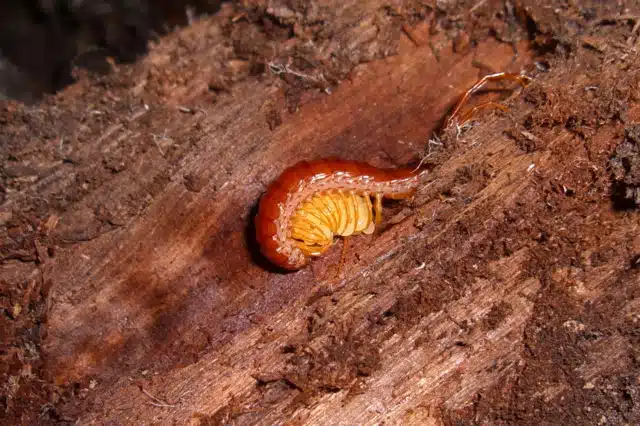
- Seeing cockroaches, spiders, and other pests
All other pests seen inside the house are warning signs centipedes will follow. You should not overlook ants or roaches inside the house as these attract centipedes.
It’s best to treat all pests the same and try to remove them and keep them out of the house for good. While seeing other pests doesn’t necessarily mean centipedes will follow, it’s rare to see centipedes in a home without other pests.
How to Get Rid of Centipedes in The Basement
The basement is the preferred space of the house for centipedes followed by the ground floor. They rarely venture to other upper floors. To eliminate centipedes is to reduce their habitat and control the environment in the basement.
Some people only recommend removing centipedes instead of killing them. The following measures can be applied both for deterring and for killing centipedes, depending on the home’s level of infestation.
Try boric acid
Boric acid acts as an insecticide. It can be used according to the guidelines on the label against centipedes. Boric acid can also be used for most other pests found inside the house.
Try Epsom salt
Epsom salt is one of the minerals used to keep centipedes away. This type of salt is different to table salt through its magnesium and sulfur content. It kills centipedes in the right dosage.
Epsom salt can be mixed with water in a ratio of 1 cup per 5 gallons and then sprayed on centipedes. This is going to either kill them on the spot, within minutes, or within a few days.
The key is to apply sufficient water-Epsom mix until centipedes run away as they will try to make a quick escape.
Epsom salt should be used with caution according to the directions on the label, especially in homes with children and pets.
Use a powerful vacuum cleaner
A good vacuum cleaner can be used to clear out centipedes in the basement. This includes the areas under furniture or behind dryers known to shelter centipedes and to offer them a dark place to hide.
Hire an exterminator
Exterminators might be needed in case of serious infections. Proper insecticide might be applied by professionals following a thorough examination of all of the home areas where centipedes live.
How to prevent centipedes in the basement
Prevention is the best method of dealing with centipedes. It’s easier to keep them out than to remove them in case of a serious invasion.
Control air humidity
Air humidity levels impact the chances of centipedes making their way indoors. Furthermore, reduced indoor humidity also limits the possibilities of some roaches making their way indoors as well.
Centipedes cannot survive for a long time whenever exposed to dry air. They need constant humidity as in tropical climates to survive.
Remove food traces that attract pests
Food traces aren’t the main attraction for centipedes. But they’re the main attraction for silverfish and other bugs and insects that make their way indoors that centipedes love to eat.
It’s best to keep food in containers. Even dry food such as flowers, rice, and pasta should be stored in airtight containers to exclude possible pest invasions.
Remove clutter that attracts pests
Clutter is one of the demonstrated elements centipedes by love. Apart from humidity and pests, centipedes love clutter. They hide behind clutter when you switch on the lights in the basement.
Clutter also traps humidity not allowing proper ventilation. It’s best to remove unused items such as old armchairs, old clothes, unused wardrobes, cardboard boxes, and other types of clutter from the basement as these provide nesting sites for centipedes.
Seal cracks
Wall cracks provide ideal access to the house for centipedes. They make their way indoors through the same cracks other pests enter the house.
Temporary solutions for these wall cracks include sprinkling Epsom salt or spraying insecticides inside. However, they need to be permanently sealed to keep centipedes away.
Use centipede traps
Sticky traps are among the most useful solutions against centipedes. They are made with a sticky substance applied on a piece of paper or cardboard which can be inserted under furniture or placed in any corner of the basement to catch centipedes.
Use insecticides
No-contact insecticide sprays are recommended against centipedes. You can consider insecticides based on cypermethrin against these arthropods.
Add more lights
Centipedes are known to prefer dark habitats. Using a yellow compact fluorescent light is recommended against the arthropods. These lights can be installed in basements, areas which are known to have reduced or even no natural light.
Hand-pick centipedes
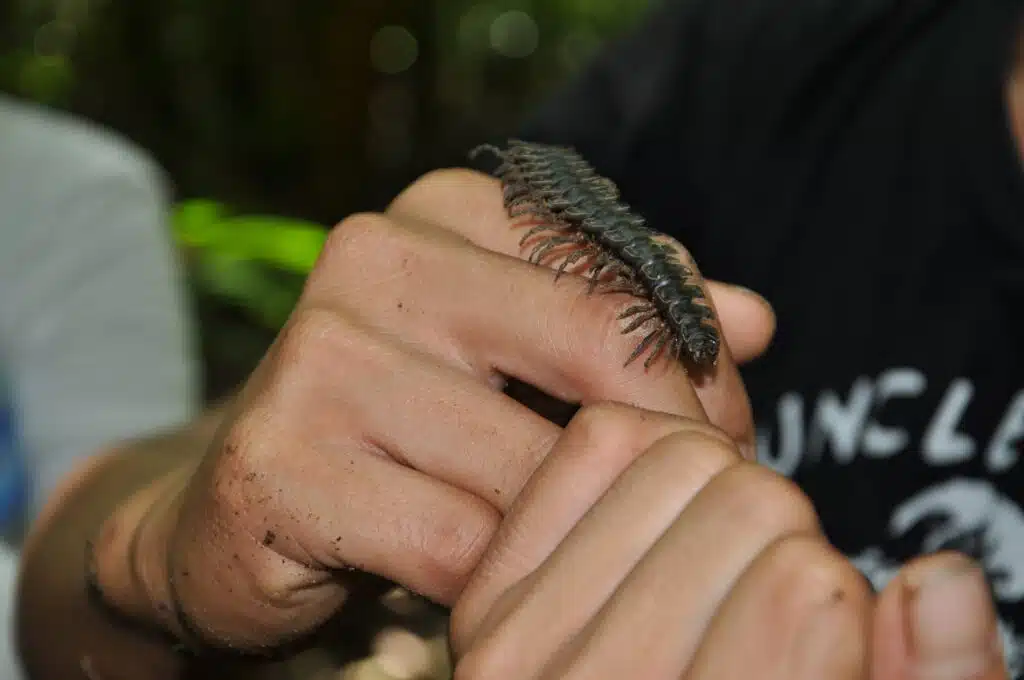
Alternatively, you can consider hand-picking centipedes if you fear they might run away before getting the vacuum cleaner.
It’s best to use protective gloves when it comes to picking up the centipedes to avoid bites. This method is among the fastest to individually remove centipedes.
Once you have them in your hands it’s best to take them outside as far as possible from the house.
Centipedes are also known as nature’s exterminators. This is why they can be beneficial in the garden where they control flower and plant pests.
FAQ
Vinegar can deter centipedes from a given area due to its pungent scent. Pure vinegar is recommended instead of 50-50 water-vinegar mixes so that its odor lingers on longer.
Sprayed water doesn’t kill centipedes. These arthropods prefer high humidity environments. Flooding kills centipedes and it’s one of the reasons they make their way indoors during storms and heavy rain.
While salt dehydrates it doesn’t kill centipedes and it doesn’t deter them. Centipedes don’t eat salt as they only eat other insects and bugs. Epsom salt (high in magnesium and sulfur) is known to kill centipedes.
Bleach doesn’t work unless directly sprayed on centipedes. It’s often used to clear out drains from the organic residue as this residue attracts the roaches centipedes to enter homes.
Raid can theoretically kill centipedes. It needs to be sprayed directly on centipedes for a few seconds. The main problem with this solution is the actual speed of centipedes as they can always make a quick escape.
Neem oil or Margosa oil is successfully used to deter centipedes, but not kill them unless exposed to very high quantities. This type of oil works similarly to essential oils. However, it has a sulfur-like smell that keeps centipedes away.
The insecticide kills centipedes. Bifenthrin is one of the agents in insecticide successfully used against centipedes.
All types of insecticide should be used as per the label of the product. Wearing protective gear is important during the process.
Most people are going to benefit from calling a pest control professional when it comes to spraying insecticide through the house to control centipedes.
Lysol can be used to kill centipedes. This is a type of strong disinfectant that can be applied throughout the basement and directly on centipedes to clear out the house.
Borax and boric acid have been successfully used against centipedes. This type of solution comes in a powdered form which is typically applied to common entry points around the house. Applying borax in cracks and openings is recommended to keep centipedes away in homes without kids and pets.
Bug spray may or may not kill centipedes depending on its concentration. Even the most concentrated bug sprays require heavy direct application to eliminate centipedes.
Peppermint oil, cedar oil, and cypress oil are all essential oils known to repel centipedes. They need to be applied every few weeks around the house to create a lasting barrier against centipedes.
Lavender naturally repels centipedes and insects. Lavender plants do not deter centipedes when found next to the house. Lavender essential oil sprayed in basements and on the ground floor of the house may deter bugs and centipedes.
Windex is one of the classic American window cleaners. It doesn’t work against centipedes unless applied in very large quantities. This is impossible most times as centipedes make a quick escape.
Natural pesticides such as diatomaceous earth kill centipedes. However, these aren’t safe to use in residential homes as they affect plants, pets, and even home residents.
Centipedes are often seen as insects. However, they are types of invertebrates of the Myriapoda genus. Centipedes are known for their long bodies split into segments. Each segment has a pair of legs. Centipedes are also known for being venomous.
Centipedes eat bugs and insects. Most centipedes found inside the house are known to eat spiders and roaches. They also consume flies and ants whenever found indoors or outdoors.
Centipedes that live outdoors are dominant. They lay eggs in rotten logs found on the ground. Indoor centipedes need to lay eggs in dark humid locations that aren’t exposed. This includes basements and remote areas of basements.
Many centipedes are found around house plants. The damp soil of the plants attracts centipedes. They rarely do anything to the plants themselves, but it’s still wise to take them out.
Hand-picking centipedes off indoor plants might be the only solution to removing them. In the long-term it’s recommended to limit the amount of plant watering as constantly damp soil is going to attract centipedes as it provides the perfect shelter while indoors.
Summary
You can get rid of centipedes in the basement by controlling the number of pests your home has. Pests are known to attract all types of bugs and flies that centipedes eat.
Controlling humidity levels is also recommended as high humidity is always needed to sustain the life of centipedes. Finally, all areas of the house which suffer from cracks and crevices the small arthropods can crawl through the need to be properly sealed.
Further Reading: